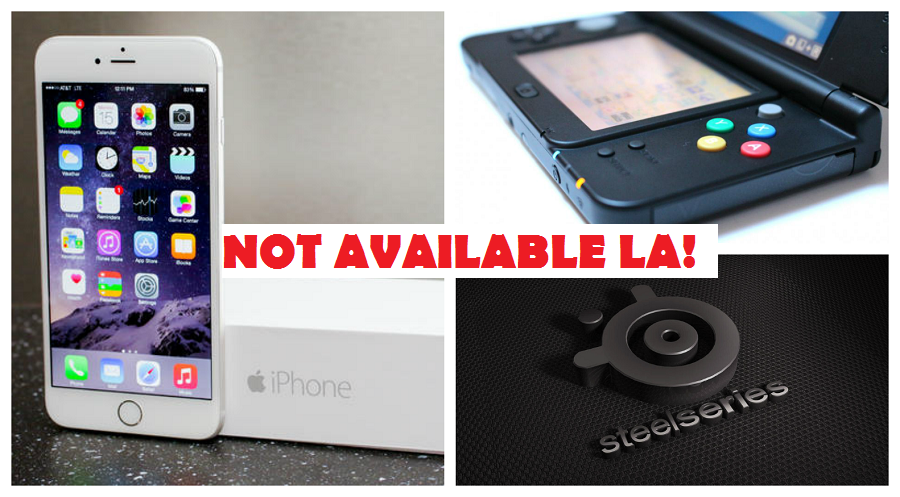My girlfriend bought me a gift last week — it was a pair of headphones. I’ve been telling her about my boss shouting over Skype calls every day, and complaining to her about our sales team shouting whenever a sale has been made. I cannot concentrate on writing. So what a perfect a gift she gave me on our anniversary — the gift of silence while working. (Hi sales team!)
The headphones were bought at Datablitz, a tech and gadgets distributor in the Philippines. It came with a 7-day warranty.
7 days.
Next week, I plan to buy a new Nintendo handheld (US Version), probably also from Datablitz or another import retailer. Why these stores? Well, firstly, Nintendo doesn’t operate in the Philippines. Secondly, the store is just a few blocks away from my workplace.
This technically means that I will be buying a grey import — a product not officially available/distributed in the Philippines. The import retailer is a grey importer, bringing in these products so that they will be available locally.
The SteelSeries fiasco

Last week, Datablitz was put under the spotlight when it was revealed that it was not authorized to sell SteelSeries merchandise, such as their gaming peripherals and headphones. (Datablitz has already responded to the allegations.) The SteelSeries already has official distributors in the Philippines, who offer — get this — 1 year warranties.
1 freaking year. Compare that to the 7-day warranties that come with items purchased from grey importers, which one will you choose? Will you buy from the official distributor, who charges more but gives you more consumer protection if the product has defects? Or will you buy from a grey importer, whose products cost less and have stores probably nearer to where you are?
Why we patronise grey imports
There are many reasons why we continue to buy grey imports.
The most common reason is that these devices are not officially available in the country. The Nintendo handheld I am planning to buy is not officially marketed or distributed in the Philippines. There’s no way to buy it but through sites like Amazon, Play-Asia, or some other American online store. But like most Filipinos, I’m still not really into online shopping. The better solution? Buy it from an import retailer such as Datablitz or iTech. Just go to the mall, and order or preorder it from there — things are easier that way.
You also don’t have to go through the complicated process of importing. That way, we will personally avoid having to go through the country’s Bureau of Customs (where all imported products go through). After all, we know how this process often ends up. The worst thing that could happen? You get charged four times the cost of the item, just because of custom fees!
Another reason is because it takes longer for a product to officially arrive in our home country. Months passed before the iPhone 4 was locally launched in the Philippines. The same goes for the official PlayStation 4 and Xbox One, even though they have been available elsewhere for months. Also, the official product is sometimes not as feature-rich as their import counterparts. For example, gamers prefer importing North American Nintendo 3DS systems than Asian versions, because the former has things the latter does not have.
In some instances, the item is actually available in the country. However, the number of official distributors/service centers are limited. Case in point: Xiaomi. Most of the time, these exclusive distributors are in the cities, or in my case, in Manila, where most of the malls are. If I were from Bohol in Central Philippines, I would have to fly all the way to the capital just to get the device I wanted. Yes, the correct way might be to order from them and then just pay for the shipping. But with an import retailer just a few hundred meters away, why would I go though all that fuss?
In rare cases, the import item is cheaper that the official product for the market. This is the case for the iPhone in Korea. Anyone in their right mind would just buy the cheaper, identical item, as the money saved could go into buying games or even an additional gadget.
Why it’s bad

With all the good things I associate with grey imports, I can only think of one damning thing about it — warranty.
Warranty is a guarantee the distributor or creator of the product gives you, if — for some reason — the product has a defect or malfunctions along the way. My headphones have a 7-day warranty, which means that if I find out it has a defect — or stops working — I can return it within 7 days for the importer to give me a replacement. If the defect only manifests itself after the 7-day period, then there’ll be no such luck for me. The retailer will not replace the product because the warranty period has passed.
According to SteelSeries, Datablitz is not an official distributor of their products. If you buy their devices from official distributors, you get a 1-year warranty, unlike the import retailer, who gives you a 7-day one but denies it. So no matter what happens to your device within the first year, you can get it fixed or replaced for free.
Why a longer warranty period? It is actually simple. The SteelSeries peripherals are not cheap, and are pricier than your regular mid-range smartphones. A longer warranty makes sense because of that simple fact: buying something expensive, and then finding out it is defective, will make your head turn if a shorter warranty period is given, as it means that your money will have gone down the drain.
But do we really have a choice?

The SteelSeries has an official distributor in the Philippines. Hence, it actually makes sense to buy from these distributors rather than from grey importers. That way, buyers can be protected from sudden defects or whatever happens to that expensive product you bought.
Yes: even if you live far away from the distributor, you can get your items replaced. They probably have an online store, or ship items for free or for a small additional amount in such cases. The cost of saving a pinch of money just to get a cheaper item is nothing, in events when the device appears to have a defect. At least the warranty will cover it — and that’s the most important thing.
But what if there are no official distributors in the country? In those instances, we really don’t have a choice but to import. After all, grey importers provide a way for us to get these products without the hassle of importing them ourselves. It just makes sense that way. More often than not, grey importers probably have some warranty and replacement policies, which you have to live with.
It sucks, really, when a product we want isn’t readily available. But that’s the reality, especially here in Asia — where ironically, most of these products are made.
Do you patronize grey importers? What is your stand on them?









